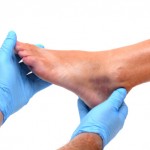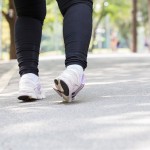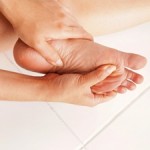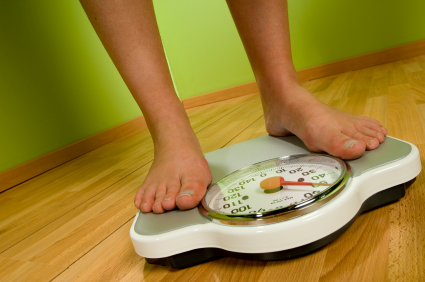Foot Health Awareness Month, diabetes foot complications, gangrene, sprained ankle, and smelly feet
April is Foot Health Awareness Month, so we have compiled a list of our stories to help inform you about diabetes, gangrene, sprained ankles, and smelly feet to help educate you on foot health. Many of us may take our foot health for granted, but when a problem does arise it can be quite serious – especially, if you are a diabetic.
The Village Podiatry Centers’ 35 podiatrists have compiled a list of helpful tips to ensure proper foot health. Their recommendations are as follows:
1. Inspect your feet daily with a mirror to check the bottom of your feet for injuries, cracks, peeling, or dry skin. This is especially important if you are diabetic to avoid infection or a non-healing wound.
2. Dry your feet and between your toes after showering to avoid fungal infections. Then, moisturize feet and heels with a good lotion.
3. Don’t leave nail polish on 24/7, as it may lead to brittle nails or fungus. Take a break for several months each year to allow your toenails to recover.
4. Apply sunscreen on your feet, between toes, and on ankles to avoid sunburn and prevent skin cancer, which often goes unnoticed in this area of the body.
5. Stretch your feet, ankles, and lower legs regularly and before exercising to keep the muscles strong and avoid injury.
6. Keep your diabetes under control and have an annual foot inspection with a podiatrist to check for problems such as loss of circulation or loss of sensation (neuropathy). These conditions often occur unnoticed and can put you at risk for infections and non-healing wounds.
7. Maintain a healthy weight through diet and exercise such as walking. Excess weight puts pressure on the feet, leading to general foot pain, heel pain, circulatory problems, and arthritis.
8. If your child complains about recurring foot pain, stumbles frequently, or has foot problems that make them unable to keep up with peers in normal activities or sports, see a podiatrist for a thorough evaluation.
9. Wear shoes with good support and a low heel. If you like to wear flats, sandals, or high heels, alternate with shoes having good arch support. Make sure your footwear has enough space without rubbing or squeezing toes. Use shoe inserts to provide arch support and cushion the feet.
10. Replace your walking or exercise shoes every six months or 500 miles in order to avoid foot and heel pain when the inside of the shoe begins to wear off and lose support.
11. As you age, your feet flatten, getting wider and longer. Most likely you will not wear the same shoe size your entire life. Have your foot measured periodically for best fit.
12. Don’t go barefooted in public places as you may suffer cuts leading to infection and contract athlete’s foot fungus or plantar warts on the bottom of your feet.
13. If you suffer a toe, foot, or ankle injury, seek medical attention from a podiatrist. Untreated injuries can result in bones not healing properly, causing recurring pain, limited mobility, and development of arthritis in the affected joints.
By following these feet health tips along with the information from our editorials, you can ensure you have healthy, happy feet.
Source:
http://www.villagepodiatrycenters.com/news-events/april-national-foot-health-awareness-month
 Diabetes, gangrene, and diabetic foot amputation risks, causes, and prevention
Diabetes, gangrene, and diabetic foot amputation risks, causes, and prevention
Diabetes can lead to many complications, such as gangrene and even foot amputation. Diabetes means the inability to control blood sugar, which results in spikes and drops. When blood sugar is not regulated, it can lead to nerve damage and impair the body’s ability to fight off infection. For these reasons, foot infections can be a common complication related to diabetes.
Because the feet are commonly exposed to injury from daily living, the risk of foot infection increases – especially, in diabetics. A foot infection for a diabetic may begin as an ulcer, but as the infection becomes deeper, it can lead to gangrene – a condition in which the bodily tissues die due to infection and lack of blood flow.
Nearly half of diabetics will experience a foot condition, whether it’s peripheral neuropathy or narrowing of blood vessels, which limits blood flow.
Gangrene, in particular, is the most dreaded foot infection for diabetics. The foot dies and begins decaying, which can ultimately lead to amputation of the foot. Continue reading…
 Diabetic foot complications lead to impaired cognitive function
Diabetic foot complications lead to impaired cognitive function
Researchers found that diabetics with foot complications may also have impaired cognitive function. “This study shows a clear correlation between diabetes and cognitive deterioration. Diabetes is a multi-system condition that affects the brain, and the risk of a diabetic developing dementia is twice that of a ‘normal’ person. Diabetic foot is a symptom that the diabetes is causing deterioration of the entire cardiovascular system,” said Rachel Natovich, Ph.D., graduate of Ben-Gurion University of the Negev (BGU).
Diabetic foot is a preventable but serious complication associated with diabetes. It begins as a nonhealing ulcer on the foot and, if left untreated, can result in amputation of the foot. A diabetic has a 25 percent chance of developing diabetic foot.
“There is no research focusing on the cognitive functioning of these patients, despite the fact that the micro and macro vascular changes underlying the diabetic foot are systemic, occurring in many different organs, including the brain. Presently, research regarding diabetic foot focuses mainly on epidemiology, prevention and ulcer treatment,” added Dr. Natovich.
The research reveals that those with diabetic foot have worsened memory, decreased concentration, difficulty learning, slower cognitive and psychomotor skills, and decreased verbal fluency. Dr. Natovich said, “This new information is an important contribution to the healthcare of patients due to their increased risk for medical complications and the unique challenge that they present to healthcare providers. Successful adherence to medical recommendations requires considerable cognitive abilities like intact concentration, memory and executive functions.” Continue reading…
 Sprained ankle risk may be influenced by foot positioning during walking, running
Sprained ankle risk may be influenced by foot positioning during walking, running
Sprained ankle risk may be influenced by foot positioning during walking and running. The findings from researchers at the University of Georgia found that the position of the foot when walking or running could greatly affect the likelihood of spraining the ankle.
The findings of the study showed that people with a history of ankle sprains had a lower clearance height between their feet and the floor during running and pointed their toes more during walking. Many individuals who experience ankle sprains will go on to have chronic instability and have a higher likelihood of frequent future sprains as well.
Lead author Cathleen Brown Crowell said, “Almost everyone who is physically active will suffer an ankle sprain at some point. Many people develop repetitive ankle injuries that are painful, can decrease performance and increase the risk of ankle osteoarthritis. We were able to identify factors in foot positioning prior to contact with the ground that may predispose some people to these repetitive injuries. These findings can help clinicians develop rehabilitation programs that address movements that may have been ignored in the past.”
The study looked at data from over 30 male recreational athletes with a history of repetitive ankle sprains and some men without. Motion capture equipment allowed researchers to observe joint mobility and force while the men walked or ran.
Brown Crowell concluded, “We can apply our findings to clinical practice. Our study demonstrates there are differences in movements at the foot and ankle in an injured population that may respond to rehabilitation interventions beyond typical stretching and strengthening. The next step is to see if targeted interventions, trying to influence how people run and walk, can treat and even prevent ankle sprains.” Continue reading…
 Natural remedies for smelly feet
Natural remedies for smelly feet
Most of us have known someone who has smelly feet or, perhaps, you have cleared out a room with your own stinky tootsies. Your hoofs, piggies, or whatever you like to call them, get a real workout. You stand with them, you walk and run, so they are bound to get sweaty and, in some cases, stinky. Up to 15 percent of the population has really bad foot odor.
Each foot has 26 bones, 33 joints, 19 muscles, and 107 ligaments, but a pair of feet also has 250,000 sweat glands. These glands can make up to one cup of sweat every day. Our feet produce more sweat per square inch of skin than any other part of our body.
A lot of the moisture that our feet produce evaporates before it has a chance to attract bacteria. However, if we wear socks and shoes that don’t allow for evaporation, that moisture can get trapped and bacteria starts to grow. At first, the bacteria cling to shoes and socks, but eventually they stick to the skin causing foot odor. While this is a common problem, it is not the only cause of foot odor. Some people with smelly feet may be experiencing a medical condition known as hyperhidrosis. People with this disorder sweat more than the body would normally need to in order to maintain optimal temperature. It is a condition that can be treated with medical assistance. People can also sweat to the point where they produce foot odor if they are under a lot of stress, take certain medications, are undergoing hormonal changes (puberty or menopause), are under the influence of drugs, or simply have poor hygiene. Continue reading…
 Stride healthy: Foot care for diabetics
Stride healthy: Foot care for diabetics
Diabetes takes a toll on the nervous system and circulation. It can reduce the blood supply to your feet and cause a loss of sensation from nerve damage known as peripheral neuropathy. This also can mean foot injuries and skin ulcers do not heal well. Worse still, you may not notice if your foot is sore or injured.
If foot ulcers do develop, it’s crucial to get prompt care. A nonhealing ulcer that causes severe damage to tissues and bone may require surgical removal – amputation – of a toe, foot, or part of a leg.
The good news is that careful diabetes management and diabetes foot care can help prevent foot problems. Better diabetes care is probably why the rates of lower limb amputations have gone down by more than 50 percent in the past 20 years, according to the Mayo Clinic.
The risk of complications can be greatly reduced if you’re able to bring your blood sugar levels under control. That also means ensuring that your blood pressure and cholesterol levels are monitored and controlled with medication if needed. Continue reading…
-
Medical Conditions That Inhibit Weight Loss
Weight loss can be a difficult goal to achieve. Some inhibitors includ
-
Lose Your Baby Weight
Many women after giving birth find that losing weight has become more
-
How to Lose Weight with Organic Foods
Many health experts agree with the organic food diet to lose weight.
-
How the Food Industry Influences Nutrition and Health
Marion Nestle Paulette Goddard Professor of Nutrition and Food Stu
-
Six Simple Steps To Lose Weight and Feel Great
Recently I read a National Center for Health Statistics report on t
-
7 Tips For Natural Ways To Lose Weight
Are you looking to drop some pounds quic
- DON'T MISS
- What Are the Best Supplements for Weight Loss?
- Gastric Bypass Surgery Better than Banding for Long-Term Health Outcomes
- This Is How To Lose Chest Fat
- Is Weight Loss Surgery Suitable For You
- Real Hypnosis, Real Results!
- How To Gain Muscle Fat
- Weight Loss Do You Know What Youre Eating
- Yogurt may boost sex drive and enhance fertility in men, besides helping in weight loss
- Can You Trust Low Fat High Carb Diet To Lose Weight?
- Some Fascinating Oolong Tea Advantages




